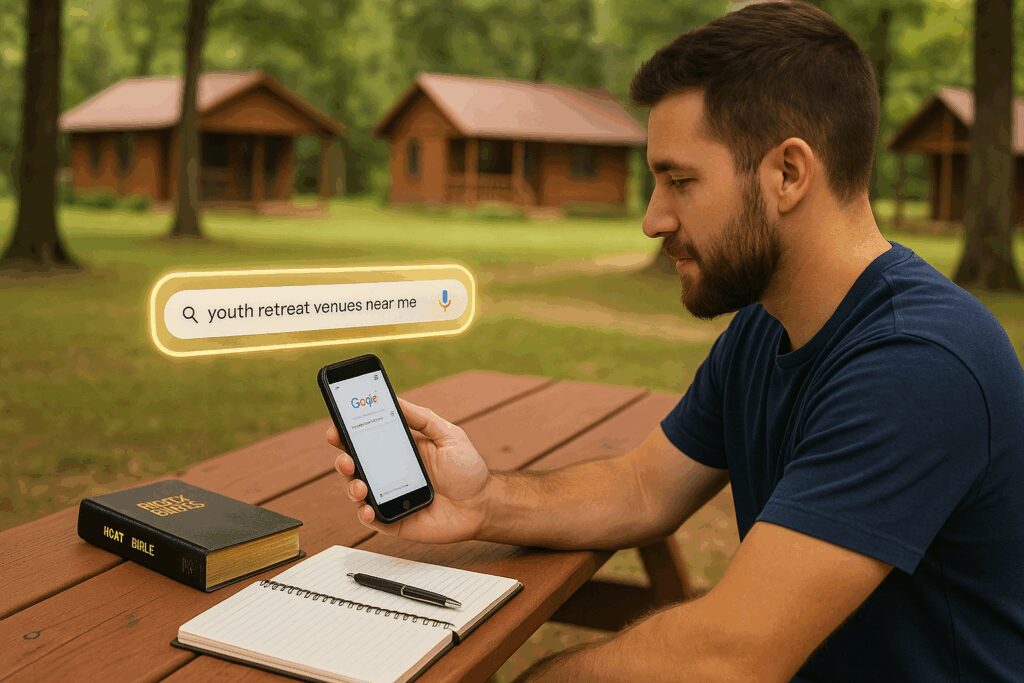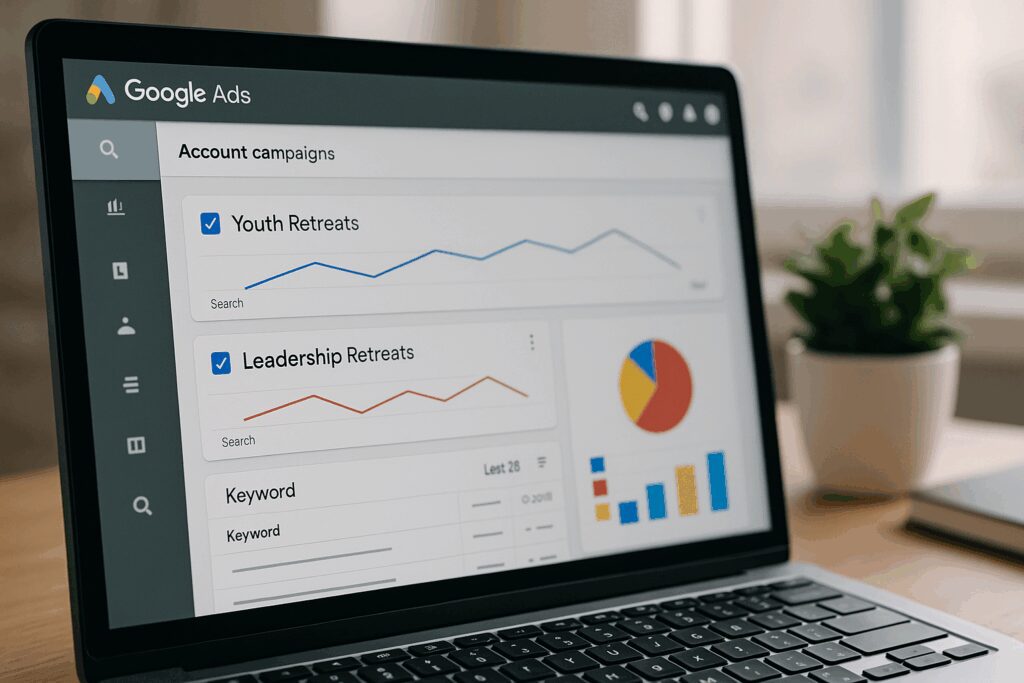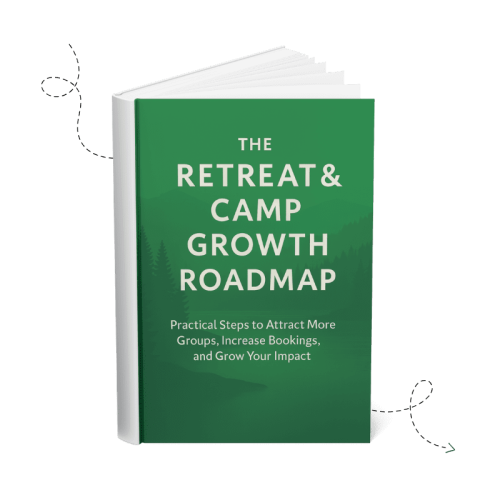Retreat & Camp Growth Roadmap Focus Area: Activate Search Campaigns
Introduction
Many retreat centers rely on referrals and repeat groups. That is healthy, but it can leave gaps in the calendar. Search campaigns let you meet group leaders at the exact moment they are looking for a place to bring people together. In fact, studies show that around 75% of people use search engines to discover new products or services, which makes showing up in those moments critical.
For retreat centers and camps, this means two important things: (1) search is where group leaders are already looking for venues, and (2) you can intentionally target only the people who show real planning intent. While building organic visibility with SEO is important, it takes time—sometimes many months before rankings improve. Paid search advertising allows you to appear at the very top of Google results immediately, with precise targeting by keyword, geography, and audience. And for nonprofit retreat centers, programs like the Google for Nonprofits Ad Grant make this opportunity even more accessible by funding up to $10,000 per month in free ad credit.
This guide shows you how to plan, launch, and optimize Google Search campaigns with stewardship in mind. You will learn practical steps, best practices, common pitfalls to avoid, and which metrics matter.
Why This Focus Area Matters
Reaching people who are actively searching for a venue to host their retreat or camp is one of the most effective ways to connect with high-intent planners. A youth pastor who types “retreat center for youth groups in [your state]” is not browsing casually—they are preparing to make a decision. While SEO is a valuable long-term strategy to earn organic visibility for these searches, it often takes time. Search advertising allows you to appear at the top of Google results right away, targeting the right keywords with precision. When planned carefully, search campaigns become a wise use of limited budget and time.
Strategically, search campaigns help you:
- Fill midweek and off-season capacity
- Introduce your center to new group types
- Reach beyond your immediate network
- Gather data on real demand to guide programs and pricing
The ministry impact is simple. When the right groups find you at the right time, you host more experiences where people connect, learn, and grow. Good stewardship multiplies that impact.
Is This an Area You Need to Focus on Right Now?
Ask yourself:
- Are you currently relying mostly on referrals or repeat groups for new bookings?
- Does organic search traffic already represent 50-60% or more of your website traffic?
- Does your organic search traffic result in a high volume of qualfied inquiries and bookings?
- Do you already run search ad campaigns and if so, are you certain they are working well?
- If you qualify as a nonprofit, are you actively using the Google Ad Grant to fund search ads?
If you answered “no” to any of these, this focus area can help you bring greater clarity, alignment, and impact to your outreach.
Putting This Focus Area into Practice
This section is designed to provide a strategic view of search ads. The goal is not to explain every technical detail of campaign setup, but to outline the opportunity, how to resource it, and how to evaluate results. The focus is on understanding the broader strategy and ensuring the right approach is in place for success.
Clarify your strategic targets
The first step is knowing who you want to reach. Not every audience is the same. Youth pastors, school administrators, and corporate team leaders search with different language and priorities. Identify which group types are most important to your mission and calendar gaps. For example, if mid-week occupancy is low, you may prioritize leadership or school groups who travel midweek. Narrow to one or two top audiences and make them the focus of early campaigns. Trying to target “everyone” dilutes impact. When you define clear targets, your team or agency can build sharper campaigns that bring in the right kinds of groups.

Evaluate the case for investment
Search ads require budget, but even small investments can produce meaningful returns. Compare potential ad spend to the value of one additional group booking. For example, if your average group booking brings $8,000 in revenue, then a $1,000 monthly ad budget may pay for itself with just one new booking. Set ROI expectations up front and revisit monthly. Ask your team to present results in terms of inquiries and bookings, not just clicks. Avoid looking only at surface metrics like impressions or clicks without connecting them to bookings. Think of search ads as an investment channel where even modest budgets can generate outsized results if stewarded well.
Resource the effort
Search campaigns need consistent attention. The question is: who will own it? You may assign it in-house to a staff member with marketing aptitude or outsource to a trusted agency. Both approaches work if accountability is clear. Define ownership, provide training or select an agency partner, and require regular reporting. Avoid adding it to someone’s job description without giving them the time or tools to succeed. Search ads perform best when they have a champion who is responsible for ongoing management and communication with leadership.
Establish success metrics
You do not need to follow every keyword, but you must know which metrics matter. The top three to track are cost per inquiry, conversion rate from inquiry to booking, and overall return on ad spend. A good click-through rate (CTR) on high-intent keywords often falls in the 5–10% range, while landing page conversion rates of 5–15% are common starting points for retreat centers. Ask your team or agency to translate numbers into outcomes, such as: “We invested $2,000, received 25 inquiries, and booked 3 groups.” Avoid focusing too heavily on vanity metrics like click volume. Clear metrics empower you to assess ROI and guide future budget decisions with confidence.
Fund with stewardship in mind
Budgeting for search ads is flexible and should be approached with stewardship. Paid ads allow you to scale spend up or down based on seasonality, while nonprofit centers can leverage the Google Ad Grant for significant savings. Use paid budgets to cover high-intent, competitive terms, and use Ad Grant dollars for broader awareness searches. Avoid treating ad spend as fixed overhead instead of an adjustable lever that should align with calendar demand. Wise funding balances cost control with the opportunity to fill your calendar and expand your impact.
Organize campaigns for clarity and impact
A well-structured campaign is easier to manage, measure, and improve. The logical approach is to organize campaigns around your core revenue streams (e.g., overnight retreats, camps, outdoor education), with ad groups for each target audience or program type. Within each ad group, keywords should match the way planners actually search, such as “youth retreat center near [city]” or “leadership retreat venue with lodging.”
Ad copy should align tightly with each ad group. Benefit-driven headlines and descriptions that highlight capacity, amenities, and the booking process resonate most with planners. Each ad should include a direct call to action, such as “Request Dates & Pricing” or “Schedule a Call.”
Equally important is where the ads send traffic. Each ad group should point to a landing page designed for that audience or program. Pages should be optimized with clear details, photos, testimonials, and a simple inquiry form so that visitors can quickly take the next step. This alignment between campaign, ad, keyword, and landing page improves performance and ensures advertising dollars produce real inquiries.
Pitfalls to avoid include cramming too many unrelated audiences into one campaign, writing generic ads that don’t speak to planners’ needs, or sending all clicks to the home page. These mistakes drive up costs and reduce results. Ensure campaign structures are organized logically and that ad copy and landing pages align with the intended audience.

Guide best practices and guardrails
Even if you are not running campaigns, you can set expectations for how they should be managed. Good campaigns target high-intent keywords, use clear planner-focused messaging, and direct traffic to audience-specific pages. Require your team or agency to review campaigns weekly, cut waste, and reinvest in what’s working. Ask for quarterly strategy reviews to ensure alignment with organizational goals. Avoid letting campaigns run unchecked or approving vague reports without understanding their implications. Guardrails ensure campaigns stay on mission and budget, turning ads into a reliable growth lever.
Leveraging the Google for Nonprofits Ad Grant
Retreat centers that operate as nonprofits may be eligible for the Google Ad Grant, which provides up to $10,000 per month in in-kind search advertising. This is a significant opportunity, but it is not automatic “free advertising.” The grant comes with rules, limits, and responsibilities that leaders should understand before relying on it.
Some nonprofit organizations hesitate to apply for the Ad Grant at first. Common concerns include uncertainty about whether faith-based organizations are even eligible, worry about the time and expertise required to manage campaigns compliantly, frustration with restrictions like the $2 CPC cap, or discomfort with relying on Google for visibility. These are valid questions to weigh. In practice, most Christian nonprofits are eligible, the restrictions can be managed with proper strategy, and many centers find the potential reach outweighs the learning curve. Understanding these reservations and addressing them upfront helps make the program less intimidating and more accessible.
The most important question to ask is not “Can we get the grant?” but “How can we use it wisely?” The Ad Grant is best applied to build awareness and visibility, while paid accounts cover the most competitive, high-intent keywords that drive bookings. This complementary approach allows nonprofit centers to stretch their reach without sacrificing quality. While the $2 CPC cap can seem limiting, Google offers bidding strategies like Maximize Conversions that help overcome this restriction when conversion tracking is in place. With the right setup, the grant can still generate meaningful traffic and inquiries.
Best practices to guide its use:
- Direct the grant toward educational or discovery searches that introduce your retreat center to new audiences.
- Align campaigns by audience type (e.g., youth retreats, leadership retreats, school groups) so reporting ties back to outcomes that matter.
- Monitor compliance by checking click-through rates, keyword choices, and account structure regularly. Policies change and must be followed to maintain eligibility.
- Insist on outcome-based reporting. Ask: How many inquiries or calls came from grant traffic? Did they convert into bookings? How do those results compare to paid campaigns?
- Pair the grant with your paid account rather than using it in isolation. Let the grant cover broader, earlier-stage searches while paid campaigns focus on the most competitive terms.
Pitfalls to avoid:
- Treating the grant as “free clicks” and filling campaigns with broad, low-quality keywords. This wastes impressions and can create compliance issues.
- Failing to review changes in Google’s policies. Non-compliance can lead to suspension.
- Sending traffic to your home page rather than to relevant, audience-specific landing pages.
What to watch: Focus on metrics that demonstrate real outcomes rather than surface activity. Key measures include compliance indicators, click-through rates, the number of qualified inquiries driven by grant ads, and the conversion rate of those inquiries into bookings. Evaluate whether grant campaigns are producing meaningful leads that your team can nurture into real group visits.
When managed thoughtfully, the Ad Grant can significantly expand visibility for a retreat center at little to no cash cost, freeing paid budgets to compete where it matters most.

Search Campaign Planning Worksheet
This worksheet helps leaders map out search campaigns at a high level before any ads are created. It provides space to identify strategic audiences, define goals for each campaign, and outline how budget and resources should be allocated. Rather than focusing on technical details, it guides your team to think about which groups you want to reach, what outcomes you expect, and how success will be measured.
Example prompts you might use with your team include:
- Which group types are our highest priority this year?
- What gaps in our calendar could search ads help us fill?
- What outcome would make this campaign a success—number of inquiries, number of bookings, or revenue target?
📥 Download the Search Campaign Planning Worksheet
Use it to set direction, align your team, and ensure campaigns are built on a clear strategy that connects directly to your retreat center’s goals.
Mini Case Study
Black Rock Christian Camp & Retreat Center provides a strong example of how the Google Ad Grant can be leveraged strategically. They structured campaigns around their core revenue streams, including overnight retreats, with ad groups tailored to each group type. They also built campaigns for camps, with ad groups for each age group and camp type, as well as for outdoor education, fundraising events, and even their gap year program. This structured approach allowed them to align advertising dollars with mission-critical areas, track results by program, and optimize accordingly.
Key lessons from their approach include:
- Structuring campaigns around revenue streams brings clarity and accountability.
- Aligning ad groups with specific audiences makes reporting more actionable.
- Using the grant to support both revenue-generating programs and donor-focused initiatives maximizes ministry impact.
For more details, see the full case study here: Black Rock Christian Camp & Retreat Center Case Study
Putting It All Together
Search campaigns give retreat centers and camps a way to be visible right when planners are making decisions. The key is not just running ads, but running them with purpose: clarifying which audiences matter most, investing wisely, resourcing campaigns properly, and measuring outcomes that connect back to bookings and revenue. Paid campaigns can deliver quick visibility, while the Google Ad Grant can extend reach and free up cash budgets for competitive, high-intent terms.
Practical takeaways to focus on now:
- Define which group types are your top priorities for the next season.
- Estimate potential return by comparing ad budgets to the value of one additional group booking.
- Assign clear ownership or select a partner to manage campaigns consistently.
- Review reports through the lens of outcomes: inquiries, bookings, ROI, and ministry impact—not just clicks.
- Adjust budgets seasonally and steward resources by pairing paid ads with the Ad Grant when possible.
- Set guardrails for best practices, ensuring campaigns stay focused on high-intent keywords, clear messaging, and relevant landing pages.
When approached strategically, search campaigns become a reliable lever to increase inquiries, fill calendar gaps, and advance the mission and stewardship impact of your retreat center or camp.
Ready to Take the Next Step?
Search campaigns can become a dependable engine for inquiries when they are focused, measured, and connected to solid follow-up. Start small, learn fast, and let the results guide where to scale.
If you found this helpful, here are four great next steps to continue your journey:
🧭 Move to the Next Focus Area: Run Retargeting Ads
Learn how to use retargeting ads as a way to re-engage past website visitors with ads that bring them back to inquire.
[Read Run Retargeting Ads Blog Article]
📘 Download the Retreat & Camp Growth Roadmap eBook
Get the full 3-stage system we use to help retreat centers and camps grow with clarity and purpose.
[Download the eBook]
🌱 Learn More About How We Help Retreat Centers & Camps
We’re a Christian-owned digital marketing agency that helps retreat centers and camps grow attendance, bookings, and impact through practical strategies rooted in clarity and stewardship.
[See How We Can Help]
🤝 Schedule a Free Discovery Call
Want help applying this to your unique situation? Let’s talk. We’ll explore where you are now, where you want to go, and how to take the next faithful step.
[Book a Discovery Call]
You don’t have to figure this out alone. Let’s build something meaningful—together.
Frequently Asked Questions
1) How much should we budget to start?
Begin with an amount you can sustain for at least 30 days of learning on one audience. Many centers see clearer patterns when a single campaign is fully funded rather than several underfunded ones. The right number depends on your market size and season, so tie your budget to a target cost per inquiry that fits your economics.
2) Should we bid on our own brand name?
Yes. Competitors can, and sometimes will, bid on your name. Branded clicks are usually inexpensive and protect your presence on the results page. Keep a small, separate brand campaign so it does not skew performance data from non-brand campaigns.
3) What is a “good” click-through rate or conversion rate?
There is no universal benchmark because audiences and offers vary. Instead, compare like-for-like. High-intent keywords often achieve click-through rates in the 5–10% range, while landing pages may convert 5–15% of visitors into inquiries. Track your own baseline for each audience and improve it over time by tightening keywords, sharpening copy, and improving landing pages.
4) How local should our targeting be?
Use your real draw radius. If most groups are within 2 to 4 hours, target those metros and counties, not the entire state. If you are a destination retreat center that regularly draws from several states, build separate campaigns by region so budgets and messages fit each area.
5) What makes a strong landing page for group planners?
Clarity and proof. Show capacity ranges, lodging and meeting spaces, dining options, activities, sample schedules, and photos of actual groups. Include brief testimonials, a simple inquiry form, and a visible option to schedule a call. Remove distractions that do not serve the planner’s next step.
6) How do we track phone calls and know which ones came from ads?
Use call tracking numbers tied to your ads and landing pages, and set them as conversions. Configure separate events for click-to-call and calls that last beyond a threshold, since longer calls often indicate real planning conversations.
7) What is the difference between the Ad Grant and paid Google Ads?
The Ad Grant provides in-kind credit for Search campaigns and comes with program policies to follow. Your paid account has full flexibility and can compete aggressively on your highest-intent terms. Many nonprofits use both, letting the grant cover educational or early-stage searches while paid ads focus on bottom-funnel keywords.
8) Are there special rules for faith-based organizations?
Many faith-based nonprofits participate successfully in the Ad Grant program. As long as your retreat center is registered as a nonprofit and complies with Google’s program policies, you can apply and benefit. Restrictions mainly apply to lobbying and discriminatory content, not general faith-based missions.
9) How long does it take to see results?
Search ads can begin delivering clicks immediately after launch, but meaningful patterns usually take several weeks of data. Plan to run campaigns for at least a month before drawing conclusions, and adjust budgets and keywords as performance data accumulates.
10) What happens if we stop running ads?





